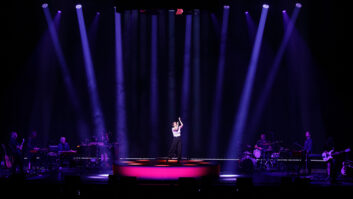London, United Kingdom (May 9, 2013)—Two Harman Soundcraft Vi6 consoles helped The London Community Gospel Choir make a world record this month for performing as the largest gospel choir ever assembled on stage. On hand were sound engineers Raphael Williams and Nikoma Bell, who manned the 96- and 64-channel Soundcraft Vi6 consoles during the performance.

The event was to celebrate LCGC’s 30th anniversary with a three-day series of performance and workshops at London’s South Bank. The highlight was the concert at the Royal Festival Hall on the Sunday, and since it was being multi-tracked for a live album and DVD, recording engineer Simon Changer also had a third, remote 96-channel Vi6, isolated in the back control room.
In order to beat the previous record of 1,138 voices singing together in concert conditions, LCGC invited 30 other gospel choirs from across Europe to participate, so that the front tier stalls of the hall also became a performance area for the extended choir (leaving the audience to occupy the balcony/under-balcony seats and upper tiers). The show included X Factor runner-up Jahmene Douglas and Magic FM DJ Angie Greaves—and the existing record was broken thanks to an ensemble of 1,169 vocalists performing simultaneously.
All the sound equipment was provided by Richard Nowell Sound Systems (RNSS). With a background in church music, Nowell said he had been contacted by the Choir “because they knew I had an understanding of their requirements.” He started out with a minor role back in 2010 before choir principle, Rev Bazil Meade, earmarked him for the lead role for this project.
While the choir itself, directed by Becky Thomas, features 50 singers, the prospect of miking up nearly 1,200 vocalists created a number of logistical pressures as he set about providing a large inventory of close and ambient/overhead mics from the RNSS inventory.
Williams, who also acted as overall technical adviser, explained the challenge he faced in compacting his line inputs. “First of all, I put together a complete list of what could happen in a perfect world; we started at 150 channels, consisting of band, acoustic section and vocals, with 40 direct mics, and a further 48 dotted around the hall. But closer to the time, I reined it in and made it more realistic in keeping with the 96-channel desk count, with nine direct mics for the main members of the choir and 12 large diaphragm mics for the remainder. These are dotted around the stage for the choir to look more artistic.”
He ended up filling his Vi6 to capacity with 30 band and 21 LCGC mics, plus four radio and 24 mics for the extended choir, eight ambient mics within the room and some playback tracks from the hard disk recorder.
With the channel count that was required to handle the recording workflow of 96 channels to a MADI device, he had to think carefully about his card configuration. “To get all 96 ins and 96 outs, I had to swap some of the cards to get more MADI outs,” he explained.
Raphael’s solution was to design a 4-card MADI card configuration based on 64-channel In, 32-channel Out (Card 1); 32-channel In, 0-channel Out (Card 2); 64-channel In, 64-channel Out (Card 3); 24-channel In, 32-channel Out (Card 4). This provided 184 channels In workflow (but only 96 channels active at any one time), and 128 channels Out workflow (but only 96 channels active at any one time).
“The Vi6 is always my desk of choice,” said Bell. “The ability to configure the show offline really helped on this occasion due to the channel count. I was using every input and output, seeing 64 lines from stage, then 12 return lines from FOH, as well as my effect returns and local inputs. But as I could configure the console on the train to rehearsals, it saved a lot of time, allowing the band to get on with what they needed to do.”
The final word came from Musical Director/Production Manager, Ayo Oyerinde. “The Soundcraft Vi6 was the central hub that enabled us to break the world record for the largest choir ever. From FOH, monitors to multi-track recording, the Vi6 took care of it all with the highest quality sound.”
Harman
www.harman.com



